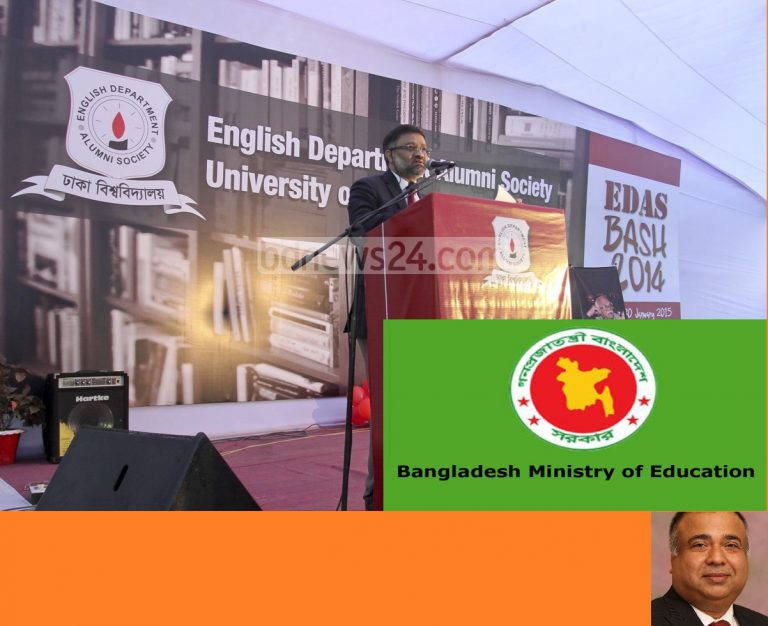Inefficient English Language Pedagogy In Bangladesh: An Applied Linguistic Perspective
The process of any second or foreign language teaching includes ‘selection,’ ‘grading,’ and ‘presentation’ as the major steps, and applied linguistics plays an instrumental role in the teaching process.
By Jilani Warsi
English is taught in Bangladesh under conditions which are far from being satisfactory and are certainly not keeping abreast with cutting-edge research in English language pedagogy. The English language plays a prominent role in Bangladesh as a lingua franca – a common means of communication – besides Bengali and a host of regional languages and numerous dialects – as a global language, and an easy medium for science and technology. However, it is a fact that despite studying English in schools and colleges for about 6-8 years, Bengali-speaking students, especially coming from rural backgrounds, are not able to communicate in English with relative ease and success. Even in some areas where students use a regional language as a first language (L1) besides Bengali – and in such areas English becomes a third language (L3) – their proficiency in the four major linguistic skills – reading, writing, listening, and speaking – is relatively low. Since acquiring a second language is a skill, it should be approached in that light. It is clear that the methods of teaching the English language in Bangladesh have not yielded the desired objective, i.e. communicative competence. In this paper, I argue that educators, second language acquisition researchers, and English language teachers in Bangladesh must approach teaching English as a Second Language from the perspective of applied linguistics and take the necessary measures to ameliorate the conditions under which English is taught in both rural and urban areas in Bangladesh. The underlying thesis of this paper is that even though applied linguistics is a science and teaching is an art, they are closely related to each other, especially in the case of teaching English as a Second Language. The process of any second or foreign language teaching includes ‘selection,’ ‘grading,’ and ‘presentation’ as the major steps, and applied linguistics plays an instrumental role in the teaching process.
The paper is organized as follows. In Section I, I discuss the problematic issues such as shortcomings in the curriculum; inefficient teachers; methods and techniques most English language teachers in Bangladeshincorporate; inappropriate textbooks; inadequate material facility; an erroneous examination system; and lack of supervision. Then in Section II, I suggest plausibly attainable ways to improve the teaching conditions in Bangladesh.
Section I Drawbacks in the Education System:
1.1 Little understanding of curricular objectives
In designing English courses for students of varying levels of proficiency, most language programs in Bangladeshi colleges and universities do not set clear curricular objectives. As a consequence, teachers are incapable of honing on specific linguistic skills. As mentioned previously, second language learning is a matter of skill acquisition. Therefore, it is in the interest of both teachers and students if the curricular objectives are clearly evinced at the beginning of the semester. For example, the curricular objectives for beginning, intermediate, and advanced courses should include the exit criteria, enabling the teacher and students to strive towards achieving the desired outcome collectively. This is not to mention that in Bangladesh a placement test consisting of problem-solving tasks related to reading and listening comprehension and writing and oral proficiency is usually not administered so that students can be placed in appropriate levels and measurable learning outcomes are not assessed.
1.2 Inexperienced teachers
In rural areas most teachers are not able to keep themselves abreast of cutting-edge research in second language pedagogy and applied linguistics. One hopes that with the advent of the internet more and more English language teachers will educate themselves on recent trends in language teaching and incorporate best practices in lesson planning and delivery. It is needless to say that students are the ultimate beneficiaries of the teachers’ diligence. Advancements in understanding how the human mind works and the psychology of learning have been made, but teachers in Bangladesh, especially in rural areas, have not benefitted from these discoveries. The Ministry of Education ought to be promoting teacher training to equip language practitioners with effective pedagogical tools. Professional development workshops on teaching English as a Second or Foreign Language can help fill the evident gap in the system.
1.3 Defective methods
Despite Chomsky’s (1957) groundbreaking work revealing that language is not primarily learned through imitation, the obsolete translation method is still being adopted by most language programs in Bangladesh, especially in rural areas. While it is true that there are certain advantages to using the learner’s first language in teaching the second language, in this case English, the disadvantages far outweigh the ephemeral benefits. According to Van Patten (2005), first language learning and second language acquisition are similar at the core. Therefore, it is reasonable to assume that just as the child learns a first language through exposure to a vast amount of auditory input, second language learners will also gain speaking proficiency by listening to both authentic and connected speech in English and by doing oral work in academic contexts.
Contrary to that, most English language programs in Bangladesh in rural areas neglect oral work and engage students in translating text from Bengali into English and vice versa. The translation method impedes the acquisition of syntactic structures in that it relies heavily on isolated chunks of grammar, ignoring the context in which the sentences are uttered by native English speakers. Furthermore, the translation method begins with the teaching of reading, ignoring prosodic features of the target language. It is ineffective in that communication skills are neglected and a great deal of stress is laid on rules and exceptions. There is increasing recognition in second language acquisition research of the communicative approach being more effective than the translation method. For this reason, the communicative approach to teaching English as a Second Language should be adopted in Bangladesh.
1.4 Inappropriate books:
English as a Second Language textbook publishers in the US and the United Kingdom pay a great deal of attention to the selection and grading of structures – including both content and form – as they target students of varying levels of proficiency. Using the communicative approach, grammar rules are taught through content that subsumes a wide array of sociolinguistic topics. Considering the teachability and learnability hypothesis, which stipulates that ESL instructors be sensitive to what can be taught and what can be learned, simple rules precede complex ones in terms of presentation, exercise, and assessment. Despite this, textbooks in Bangladesh are not geared towards honing on the linguistic needs of the learner, considering whether or not the learner is at the appropriate developmental stage to acquire the target language structures.
The impact of inappropriate textbooks on the learner’s language growth is further decimated by the grim fact that the teaching of language is not given emphasis. As I have mentioned previously, emphasis is on reading and writing without thoroughly understanding syntactic rules that govern semantic interpretations, which undermines the learner’s ability to set new parameters in the second language.
1.5 Inadequate material facility:
Second language acquisition research delineates that audio-visual aids such as flash cards, charts, pictures, models, filmstrips, tape recorders, computers, and overhead projectors facilitate successful acquisition of a second language. Despite this, there is a widening gap between what research shows and what actually transpires in English language classrooms in Bangladesh. It should be noted that I am referring to language classrooms in rural areas. It is the case that in most major educational institutions in Bangladesh, especially in metropolis, language learners have access to audio visual aids. Nevertheless, state-of-the-art language labs are still a rarity in most colleges and universities. Patrick Winston, who directs the Department of Artificial Intelligence at Massachusetts Institute of Technology, argues that human intelligence is buried in the linguistic system and the visual system (2002). It is, therefore, in the interest of the learner if teachers rely on ancillary audio-visual aids in the classroom to tweak the learner’s linguistic and visual systems and accelerate the learning process. In general, though, most English language facilities in Bangladesh lack audio-visual aids, which are proven to be conducive to language learning.
1.6 The faulty examination system:
There exists a gap between the prescribed English textbooks and the cognitive problem-solving tasks on the exam for the purposes of assessment. Since the exit criteria are not specifically laid out at the outset, the learner is faced with an exacerbating problem – answer questions that were not addressed by the language instructor during the semester or demonstrate the ability to understand content that was not covered in the textbook.
The objectives of second language pedagogy and assessment should be:
* To develop the learner’s intellectual power through a second language, in this case English,
* To enhance the learner’s personal cultural values through the study of second language literature and philosophy,
* To increase awareness of the mechanism of the learner’s native language through a second language,
* To keep the learner abreast of current writing and research in her or his respective discipline,
* To enable students to communicate orally in their second language,
* To assist the learner in acquiring reading, writing, listening, and speaking skills,
* To expand gradually deepening knowledge of a foreign country, and
* To help the learner appreciate cultural experiences through improved second language skills.
Most English language exams exhibit a glaring omission of the aforementioned objectives. It is needless to say that the learner stands to gain from these objectives, as knowing about implicit cultural values of the target language expands her or his world view.
It goes without saying that formal tests are an attempt to construct an instrument for measuring ultimate attainment, or progress, or ability in language skills. Clearly, each of the qualities can be assessed in terms of each of the four basic linguistic skills. A test of attainment in understanding the spoken language, for instance, can be used to test the learner’s command of the language at the phonological level and to discover how far s/he recognizes the phonemic contrasts of the language. This obviously would be a test of the learner’s second language speech perception. Similar tests can be designed to evaluate the learner’s speech production.
In contrast, almost all tests in English in Bangladesh, are, in fact, examinations: they are subjective in their setting and marking in that they only cover the skills of reading and writing. They measure the pupils’ knowledge of the language rather than their performance in it, and they confuse the testing of language with literary and cultural attitudes and knowledge.
1.7 Lack of supervision:
The primary objective of a teaching organization is to disseminate knowledge and to assess how successfully or unsuccessfully the instructor is accomplishing this task. Periodic observations are employed to determine how effective the instructor’s teaching is and how much s/he is adhering to the curricular objectives and performance standards. That is to say, an observation is conducted to ensure to what extent learning is taking place among the pupils in conformity with the curricular objectives. It is logical that a system of supervision is required so that the instructor can be provided with constructive criticism as to whether or not the desired objectives are met. In other words, the instructor needs a feedback mechanism to closely monitor the effectiveness of her or his teaching. The language school needs to know how far the classes are progressing in accordance with the teaching and learning objectives. Last but not least, the education system needs a way of measuring progress in different regions of the country.
Unfortunately, no such efficient system is in place in Bangladesh. In particular, there is a dearth of trained specialists in rural areas who can be engaged in such tasks and provide immediate feedback to the instructor. This lack of supervision allows most English language instructors to be complacent about their teaching, which exacerbates the existing teaching conditions in Bangladesh. Because of this complacency, most instructors do not take a proactive role in their professional development and are by nature inflexible.
SECTION II Recommendations For Improvement In Teaching English:
2.1 Setting realistic curricular objectives
Curricular objectives in line with teaching English at various stages of development must be specified at the beginning of the semester. Some of these objectives can be thinking critically and questioning the basic premise of authors’ claims, being able to paraphrase and summarize the original text, recognizing the main idea, identifying supporting details, determining word meaning from context, making inferences, and formulating a thesis statement, the bane of most graduate students in the US.
One can readily see the implications of the above objectives for teaching and learning English as a Second or Foreign Language. For example, the ability to think critically and interact with people of diversified social and linguistic backgrounds is germane to the importance of successfully performing in a global society. It should be noted that English is gradually becoming a global means of communication for people who speak it either as a second language or a foreign language. Therefore, it is in the interest of Bangladesh as a nation that the curricular objectives, regardless of whether English is taught in rural or urban areas, are clearly defined and that language instructors strive towards achieving them.
2. 2 Training Teachers
It is imperative that teachers be deeply grounded in linguistic theory and second language acquisition research. The Ministry of Education in Bangladesh ought to be encouraging language teachers to present at professional conferences within the country and overseas so that they can keep themselves abreast of current trends in second language pedagogy and applied linguistics. The tendency among directors of English language institutes in Bangladesh is to hire teachers with little or no background in Teaching English to Speakers of Other Languages (TESOL), grossly ignoring the fact that language teaching is a skill which must be acquired through investigation and discovery. The renowned British linguist, David Crystal, wisely uses an analogy to respond to this attitude. He argues that having a heart does not necessarily make one a successful cardiologist. In other words, one needs to go to a medical school and learn how the human heart functions in order to understand cardiac problems and perform surgeries. The pertinence of this analogy to second language teaching is transparent. Bangladeshi English teachers need to be cognizant of recent trends in language teaching so that they may overcome their ingrained prejudices and employ effective teaching methods to enable their students to acquire the English language.
2.3 Abandoning the Translation Method
As I have mentioned previously, the Translation Method pays no attention to listening and speaking and largely focuses on literal translation. Instead of using a method that has been debunked by recent research, Content-based Instruction (CBI) must be incorporated into teaching English in rural and urban areas in Bangladesh. The logic that dictates CBI is based on the principle that language is learned through social interaction. Therefore, if students are allowed to articulate their thoughts in English regarding pertinent social, political and economic issues, then it is reasonable to assume that they will master the necessary skills, especially listening and speaking, with relative ease and success.
It should be kept in mind that English language teachers must be prudent and eclectic in designing a lesson plan, paying close attention to a wide range of methods and techniques that are at their disposal, and in selecting appropriate pedagogical tools that are congruent with the linguistic needs of their students.
2.4 Adopting Appropriate Textbooks
The Ministry of Education, Bangladesh can play an instrumental role in publishing textbooks that are written in accordance with generative grammar and the structural method containing appropriate pictures and graded exercises. Fortunately, there is a plethora of English as a Second Language textbooks, making it relatively easier for educators and policy makers in Bangladesh to adopt appropriate textbooks taking into consideration the learner’s level of proficiency and specific curricular objectives for the levels being taught.
In addition, there are several different handbooks that offer succinct and lucid explanations of the mechanics and syntactic structures of the English language. These handbooks can be used as ancillary material, especially for courses in academic writing and business English.
2.5 Incorporating Audio-visual Aids
In addition to focusing on content rather than form, audio-visual aids should be used in Bangladesh to help the learner advance the basic linguistic skills. They provide practical solutions to the problems of language teachers whose sole equipment, as a rule, consists of nothing more than textbooks and the classroom. There are several advantages of using audio-visual aids in a language classroom:
Audio-visual aids help the learner understand the English language by bringing her or him in direct contact with objects and material artifacts, by bringing the distant things near, and by bringing the world into the classroom. They help the learner appreciate the subtle nuances of different linguistic systems and cultural values.
Audio-visual aids promote remembering by involving the perceptual sense of the learners, by arousing the learner’s curiosity, by making use of pictorial content, and by providing varieties in teaching.
They make teaching effective by creating situations for presentation and practice of language items and by reducing dependence on the learner’s native language. In addition, audio-visual aids help in formation of language habits by drills, repetition, and constant practice, and they increase the learner’s experience of language by providing a rich variety and better quality of instruction.These aids increase the instructor’s efficiency by saving time and energy, and they provide recreation to the learner.
Apparently, audio-visual aids play a vital role in language teaching. Their primary function is semantic in that they permit the learner to understand what s/he hears, to learn the situation in which language forms are used, and to associate learning through repetition and limitation. It should be noted though that audio-visual aids should only be used as a catalyst to accelerate the learning process.
2.6 English Language Examinations
One of the goals of a language teaching institution is assessment. The learner’s tacit knowledge of the target language is evaluated by administering standardized reading and writing exams. It is important to note that a subjective test is one where the marks depend upon the examiner’s opinion, judgement or evaluation. It is, therefore, recommended that language schools in Bangladesh administer objective tests in which marks are gained or lost, as the case may be, solely reference to the learner’s performance in such a way that all examiners would agree on the apportioning of marks. Such tests, if they are carefully linked with a teaching program, offer a simple, rapid, and effective way of keeping a close check on teaching and learning.
Another important feature of examinations is that they are by nature inflexible. Being related to an educational system, they have an obligation to remain reasonably constant and to change only when accompanied by necessary changes in the school’s teaching method and curricula.
Yet another inescapable feature of examinations is that they control teaching, whatever techniques and principles may be developed for evaluating and contrasting language teaching which is carried out in all but the best schools in a given area in Bangladesh, and an improved course syllabus can therefore only be effective if the examination permits it to be so.
I recommend that tests of ability be administered to measure features of performance which are known to correlate closely with effective and rapid language learning. Furthermore, tests of attainment should also be conducted because they are measurements of practical performance. Last but not least, tests of progress are simply testing of attainment “per-unit-time,” a measure of the difference in the attainment of an individual at one moment and at a later.
2.7 Effective Supervision
In order to teach English as a Second Language effectively, teachers need a feedback mechanism, which enables them to learn through trial and error. Effective language teaching is about showing the learner how the language works by displaying, ordering, and adding to the learner’s use of the second language, and teachers who succeed or fail in accomplishing this task must be supervised on a regular basis. There are indeed various methods of language teaching that are appropriate for any level of proficiency at which the language teacher wishes to introduce them.
These can be related to the general concept of ‘strata’ of linguistics, or more specially strata of grammar, of lexis and so on, as the links which together make up the chain from academic ‘back-room’ linguistics at one end to classroom practice at the other.
The fist stratum is work on general linguistic theory by linguists. The second stratum is the use of this theory to describe actual languages. The third stratum is the description of a language for the use of those who teach it. Fourth comes the textbook, the work that is placed in the hands of the pupils themselves who are learning the language. The fifth stratum, which could perhaps be subsumed under the previous one, is the actual content of the classroom teaching: the methods by which the language teacher displays the language at work, the features s/he selects to illustrate and the type of language s/he uses to delineate both form and content.
Taken together, it can be said that the language teacher plays an instrumental role in determining and influencing the shape and form of learner language. It is, therefore, incumbent upon the English language programs in Bangladesh to develop a system of supervision whereby the language teacher receives constructive criticism of her or his teaching performance. This will obviously involve the painstaking task of training individuals to supervise language teachers, but it is imperative that Bangladesh undertake the onerous responsibility to enhance the prevailing English language teaching situation.
Conclusions
To conclude, the conditions under which English is taught in Bangladesh are not conducive to teaching and learning the language. Courses are taught without specific curricular objectives; English language teachers are not equipped with efficient pedagogical tools; most English language teachers rely on obsolete teaching techniques; inappropriate textbooks are chosen to teach English as a Second Language; language teaching facilities are not equipped with audio-visual aids; the examination system is erroneous, as it falls short of measuring attainment; and the education system is lacking an observation and feedback mechanism.
It is recommended that the Ministry of Education in Bangladesh seriously consider designing English as a Second Language courses with specific curricular objectives, paying close attention to the proficiency levels of the students; training teachers to ensure that they are well equipped for understanding the complicated process of second language acquisition and for teaching the English language to the Bangladeshi students; abandoning the Translation Method and incorporating Content-based Instruction in language teaching; adopting appropriate textbooks that link theory to application; using audio-visual aids to enhance the vast amount of input and raise the learner’s consciousness of the target language; administering tests that accurately measure the learner’s performance behavior; and envisaging a feedback mechanism that allows for professional development in a non-threatening, unobtrusive, and collegial manner.
The contribution of applied linguistics to a process that is primarily methodological in its nature is twofold. In the first place, and pervading the whole task, applied linguistics provides both the description of the second language and an understanding on the part of how the components make up the whole of how the language functions. Secondly, reference back to linguistic categories will ensure that in the planning of an English language teaching program in Bangladesh, all aspects of language that are relevant to the learner are included. This does not imply that phonology, graphology, lexis, grammar and context need to be taught as separate levels: these are linguistic categories, concepts for the description of language, not teaching procedures. Besides there is compelling evidence that the more closely the teaching items that fall within these categories are integrated and presented as total language behavior in a real situation, the more effective the teaching is.
Works Cited
Chomsky, N. (1957) Syntactic Structures. MIT Press: Cambridge, MA, USA
Crystal, D. (2001) World Englishes. Lecture given at the TESOL 2001Annual Convention.
Winston, P. (2002) How to Speak. Lecture given at The Derek Bok Center for Teaching and
Learning, Harvard University, Cambridge, MA, USA.
(Dr. Jilani Warsi earned MA in English included courses in descriptive linguistics, historical linguistics, and language teaching. He pursued an MA in applied linguistics at California State University in Northridge (CSUN), focusing on the acquisition of second language phonology. His Ph.D. dissertation focused on the acquisition of English /l/ and /r/ tokens by native Japanese speakers. In addition to language acquisition, he is interested in inter-language, phonology and phonetics, applied linguistics, and second language pedagogy. He taught at Harvard University, California State University in Northridge, Boston University, Fisher College, Newbury College, Salem State College, the Framingham State College’s International Education Programs in Guyana, Trinidad & Tobago, Bolivia, Costa Rica, Poland, Brazil, Honduras, Bahrain, Kuwait City, Lebanon, Nicaragua, Mexico, Italy, Panama, Mariana Islands, South Korea, Thailand, and China. He joined the English Department at Queens-borough Community College in 2004 and have taught remedial reading, writing, and English 101 courses. Linguists say that the most human thing there is about being human is language. This simple truism has always fascinated him and has sparked his interest in the complicated process of first and second language acquisition.)



















Comments